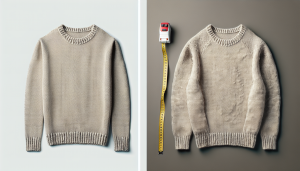
As a common garment, sweaters are made of different components and materials, each of which has its own characteristics and advantages and disadvantages. The following is an analysis of the common components of sweaters, exploring their characteristics and advantages, and disadvantages.
- Wool:
- Characteristics: Wool is one of the most commonly used components of sweaters, with excellent warmth and breathability. It can effectively wick away moisture and sweat to keep the body dry and comfortable. Wool has elasticity and softness, which can keep the shape and ductility of sweaters.
- Advantage: It is warm, soft and comfortable, breathable, and has good elasticity and ductility.
- Disadvantages: easy to shrink, easy to pilling, need special maintenance and cleaning methods.
2. Cashmere:
- Characteristics: Cashmere is the finest fleece on sheep, with excellent warmth and softness. Cashmere sweaters are light and soft, warm and comfortable to the touch, and are a common choice for high-end sweaters.
- Advantage: Excellent warmth, light and soft, delicate and comfortable to the touch.
- Disadvantages: higher price, need special care and maintenance.
3. Silk:
- Characteristics: Silk sweaters have a lustrous and elegant appearance and are soft and cool to the touch. Silk has good moisture absorption and breathability, which can regulate body temperature and keep the skin comfortable.
- Advantage: glossy and beautiful, smooth and cool to the touch, and breathable.
- Disadvantages: easy to fade, easy to wrinkle, need careful handling and cleaning.
4. Cotton fiber:
- Characteristics: Cotton fiber is a natural fiber with good breathability and moisture absorption. Cotton sweaters are soft and comfortable, suitable for the spring and summer seasons, and can keep the skin dry.
- Advantage: good breathability, moisture absorption, soft and comfortable.
- Disadvantages: easy to wrinkle and shrink, poor elasticity.
5. Synthetic fibers:
- Characteristics: Synthetic fibers such as polyester and acrylic are often used in sweater making. They are resistant to wear and tear, easy to care
- and wrinkle resistance. Synthetic sweaters are usually lower priced and suitable for everyday wear.
- Advantages: Abrasion resistance, easy care, good wrinkle resistance, lower price
- Disadvantages: Less breathable and less comfortable than natural fibers.
Each composition has its own unique characteristics and applicable scenarios. When choosing a sweater, you should decide on the most suitable type of composition according to your needs and environmental conditions. In addition, different compositions require special care and cleaning methods to maintain the quality and longevity of sweaters.



